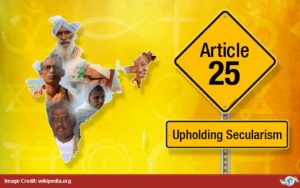JAVID AHMAD AHANGER
India officially became a secular nation in 1976 with the incorporation of word ‘secular’ in the preamble through 42nd Amendment of the Constitution. But what does secularism mean to India? Even the Supreme Court in one of its judgments said that secularism is a complex concept and very difficult to define. In the west, there is no such confusion. Secularism has three core features: equal citizenship to each citizen irrespective of his or her religion, freedom of religion and the separation of state and religion. However, in India, secularism is always perceived as anti-minority and pro-majority, that is why majority people and policymakers in India perceive the secularism as religious conflict prism. In other words, secularism in India means pro-majoritarian, i.e., to please Hindu dominated society by the narrative of Minority-phobia.
The question is why is there such confusion in India about secularism? Why is the entire discourse around secularism so confusing and puzzling in India? To understand the secularism in the Indian context, we need to explain secularism in general- its origins in Europe and its different forms. Like cricket or English language secularism in India is also a borrowed notion. Although many historians claim that India was a secular nation in its earlier times, but the fact is there was no idea of nation. It was only in recent past, due to the legacy of many intellectual thinkers and political movements against the colonial power that the term nation and secularism emerged as a political discourse in the sub-continent. While as in Europe Secularism started with the fights and intense debates among Protestants and Catholics. But as in Indian context, it was only a legacy of Britishers who gave birth to new type of political institutions and ideas in India.
Officially and Constitutionally, India is a secular state, where the rights of religious minorities are preserved in the constitution. But the history is witness to this fact, how the minorities are treated in the post-colonial state in India by the so-called the secularist and liberal voices. This sense of marginalization had increased since 1980s-90’s when the Babri Masjid and Ram Janmabhoomi questions were used to sharpen religious divisions in India. The main principles and features of this movement include protests against the so-called ‘love jihad’ and ‘Ghar Wapsi.’ Fixed practice from various forces for de-secularization, which do not portend well for religious minorities and Muslims in India. The three main phases of the Ram Janmabhoomi movement were ‘Shilanyas Yatra’ of 1989, BJP’s L.K Advani’s ‘Rath Yatra’ of 1990 and the demolition of the ‘Babri Masjid’ in 1992. The ideology of Sangh Parivar and other communal organizations dates to pre-independence India. It made its appearances even during the freedom movement when many a nationalist leaders made the fatal mistake of giving an anti-British movement Hindu cultural touch. The emergence of Muslim separatism before and after the partition partly sprung from apprehensions of Hindu communalism that was passed off as cultural nationalism. Two nation theory and the birth of Pakistan was substantially failure of Indian secularism to address the issues of religious minorities. After the assassination of Gandhi at the hands of a Hindutva zealot, Hindu communalism that had already crept in remained dormant for some time. However, this dormancy was in effect its incubation period. The environment was sufficiently poisoned with communal hatred 1990’s when the ugly monster appeared and razed 16th century Babri Mosque to ground in less than a day. It was the fruition of Advani’s ‘Rath Yatra’ as well. The day spelled the death of Indian secularism yet again.
Sadanand Dhume, one of the leading scholars, criticizes Indian secularism in a Wall Street Journal and calls it a ‘fraud.’ Indian Muslims have always been taken for granted and offered a minimal political deal in return for their votes. Thus mainstream, liberal politics in India has deliberately failed to treat the Muslim as an Indian. One of the most critical ways of sustaining the nation is secularism, democracy and promoting equitable regional developments. However, the problem with the present government led by Modi under the banner of RSS and other communal organization is that it lacks inclusiveness and fair participation of minorities.
Post-Script:
Quaid-i-Azam, Muhammad Ali Jinnah, must be smiling in his grave, because the way Sangh and RSS have created the terror among the minorities in India, especially among the Muslim. The obnoxious spread of fear among minorities by the Hindu right-wing forces under the nose of incumbent BJP regime vindicates Jinnah’s two nation theory seventy years after it was rejected by secular Indian nationalists. Paul Brass, one of the leading authority on Indian politics quite aptly said, “India is not heading for catastrophe but is a living catastrophe, and its people including intellectuals know it…he further added that Hindu Nationalism is a dangerous thing if it succeeded it will destroy India.” Nevertheless, it is intellectuals and ordinary citizens who must act like the opposition, because so-called secular political oppositions have deceived the Minorities and Muslims greatly, and people of India are paying the cost. If they will not act, then it is high time to drop the term ‘secular’ from Indian Constitution and political discourse in India.

